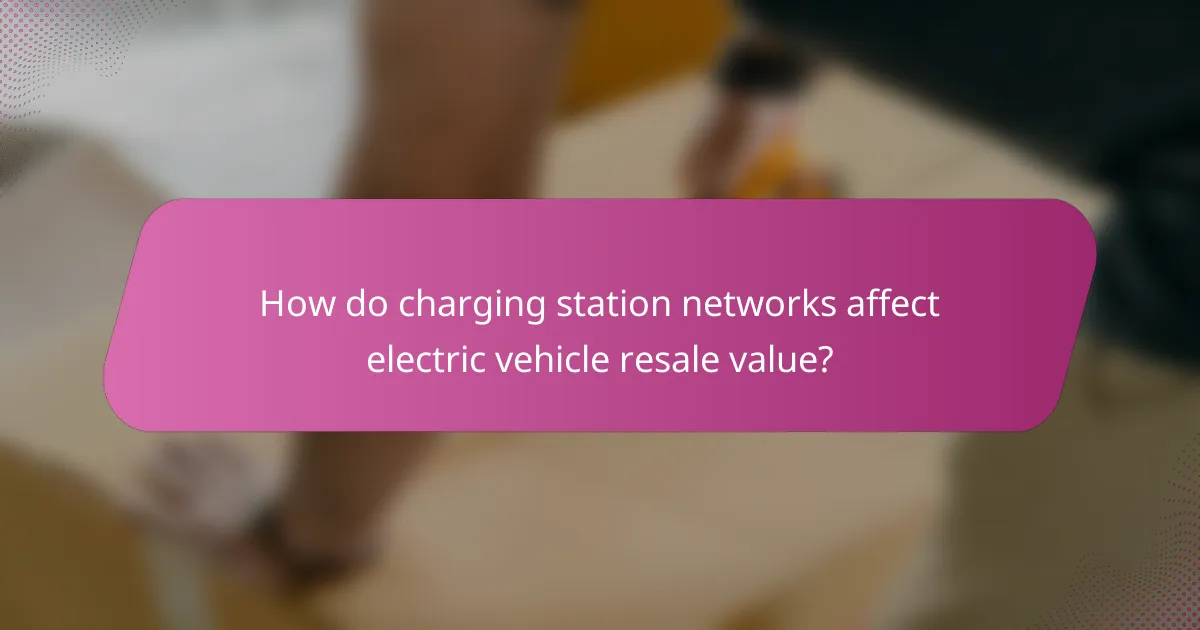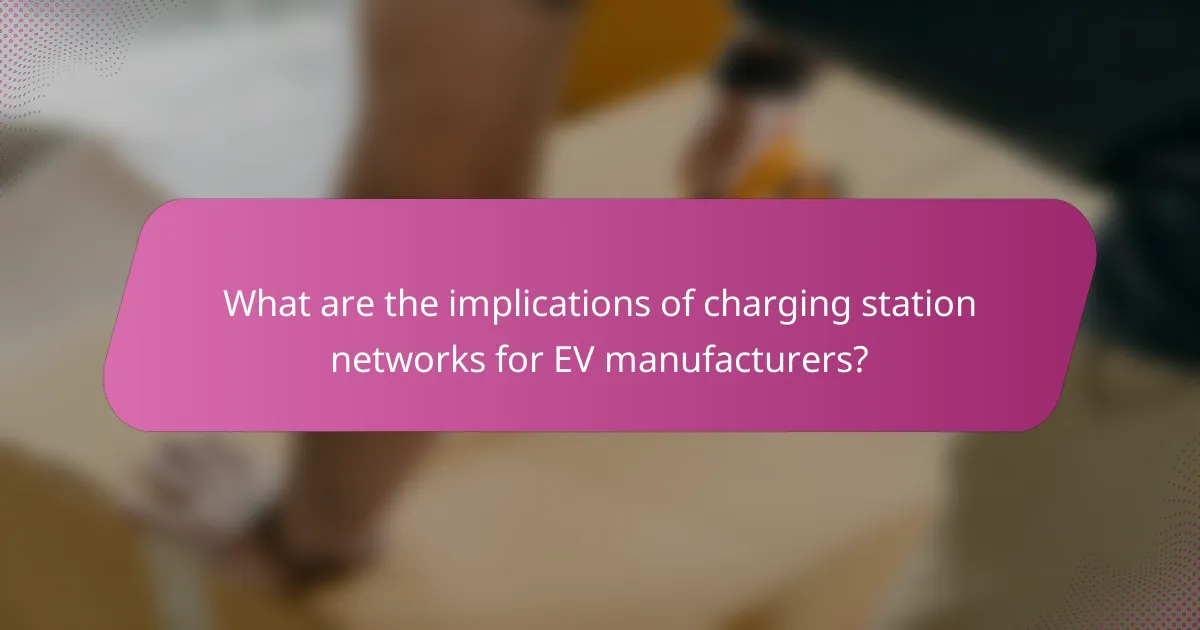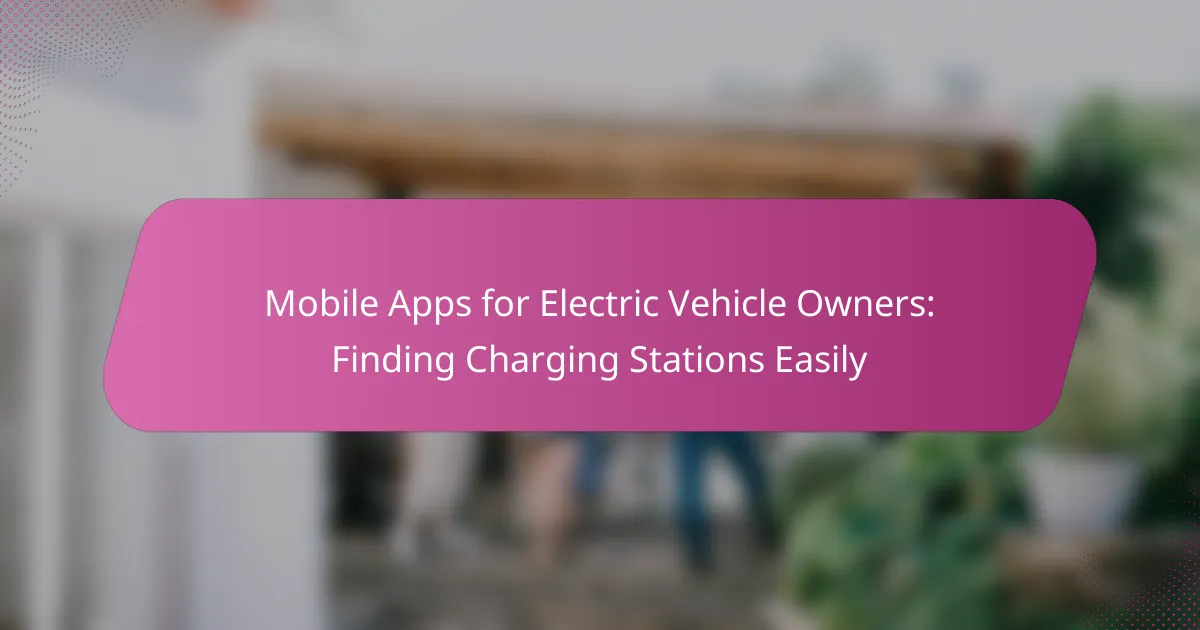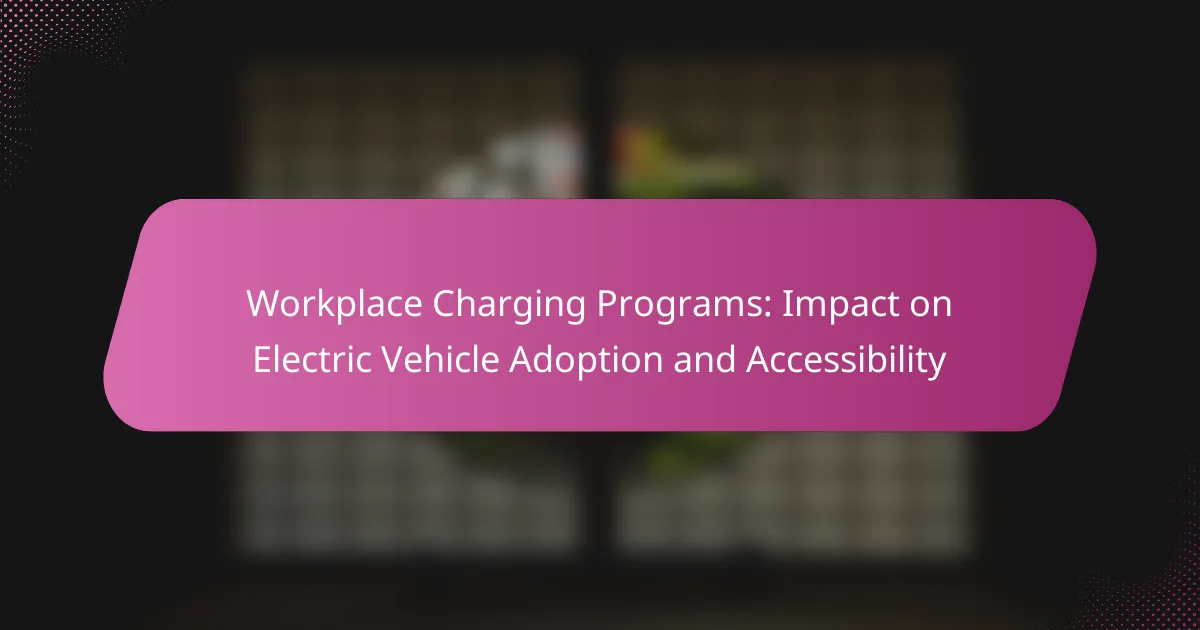Charging station networks play a crucial role in shaping the resale value of electric vehicles (EVs) by improving their practicality and appeal to consumers. As the charging infrastructure expands, it boosts consumer confidence and demand, ultimately leading to higher resale prices. Additionally, the growth of fast-charging stations and supportive government incentives are driving trends in the EV market, making ownership more convenient and attractive.

How do charging station networks affect electric vehicle resale value?
Charging station networks significantly influence electric vehicle (EV) resale value by enhancing the overall appeal and practicality of owning an EV. A robust network of charging stations increases consumer confidence, leading to higher demand and better resale prices.
Increased demand for EVs
The availability of charging stations directly correlates with the demand for electric vehicles. As more charging infrastructure is developed, potential buyers feel more secure in their decision to purchase an EV, knowing they have convenient access to charging options. This increased demand can lead to a more vibrant resale market.
Regions with extensive charging networks often see a surge in EV sales, as consumers prioritize convenience and accessibility. Consequently, manufacturers may respond by increasing production, further driving down prices and enhancing market competition.
Higher resale prices in well-networked areas
Electric vehicles in areas with a well-established charging station network tend to command higher resale prices. Buyers are willing to pay a premium for vehicles that offer the assurance of easy charging access, which translates to better long-term value. For instance, EVs in urban areas with numerous charging points may sell for tens of percent more than similar models in regions with limited infrastructure.
In addition, the presence of fast-charging stations can further elevate resale values, as they reduce charging time and enhance the overall ownership experience. This trend is particularly evident in metropolitan areas where consumers prioritize convenience.
Impact of charging accessibility on buyer preferences
Charging accessibility plays a crucial role in shaping buyer preferences when it comes to electric vehicles. Many consumers consider the proximity and availability of charging stations as a key factor in their purchasing decision. If a potential buyer lives in an area with few charging options, they may opt for a traditional vehicle instead.
Moreover, buyers often prefer EVs that are compatible with various charging networks, ensuring they can charge their vehicles easily wherever they travel. This preference highlights the importance of not only having charging stations but also ensuring they are user-friendly and widely accessible.

What are the market trends in electric vehicle charging infrastructure?
The electric vehicle (EV) charging infrastructure market is experiencing significant growth, driven by increasing EV adoption and consumer demand for convenient charging options. Key trends include the expansion of fast-charging stations, the growth of charging networks like ChargePoint, and government incentives aimed at enhancing charging infrastructure.
Growth of fast-charging stations
Fast-charging stations are becoming increasingly prevalent, allowing EV owners to recharge their vehicles in a fraction of the time compared to traditional chargers. These stations typically provide charging speeds that can add significant range in as little as 30 minutes, making long-distance travel more feasible for EV users.
As consumer preferences shift towards faster charging solutions, many companies are investing in the development of ultra-fast chargers that can deliver up to 350 kW. This rapid growth in fast-charging infrastructure is essential for supporting the expanding EV market and ensuring that drivers have access to quick and efficient charging options.
Expansion of charging networks by ChargePoint
ChargePoint is one of the largest charging networks in the United States, continuously expanding its footprint to meet the rising demand for EV charging. The company operates thousands of charging stations across the country, providing users with convenient access to charging points in urban and rural areas alike.
By partnering with businesses, municipalities, and property owners, ChargePoint is enhancing the availability of charging stations in high-traffic locations such as shopping centers and workplaces. This strategic expansion is crucial for alleviating range anxiety among potential EV buyers and promoting broader adoption of electric vehicles.
Government incentives for charging infrastructure
Governments worldwide are implementing various incentives to promote the development of EV charging infrastructure. These incentives may include tax credits, grants, and subsidies aimed at reducing the costs associated with installing charging stations.
In the United States, for example, the federal government offers tax credits for the installation of EV charging stations, which can significantly lower upfront costs for businesses and homeowners. Such initiatives are vital for accelerating the growth of charging networks and supporting the transition to electric mobility.

How do charging station networks influence consumer purchasing decisions?
Charging station networks significantly affect consumer purchasing decisions by providing essential infrastructure that enhances the convenience of owning an electric vehicle (EV). The availability and accessibility of charging stations can sway potential buyers towards specific models and brands, impacting overall market trends.
Consumer preference for locations with charging options
Consumers increasingly prefer locations that offer convenient charging options, as this directly influences their daily usability of electric vehicles. Areas with robust charging networks, such as urban centers or near major highways, tend to attract more EV buyers who prioritize accessibility.
For instance, a home located near multiple charging stations may be more appealing to potential buyers, leading to higher resale values. Buyers often seek properties that provide easy access to charging facilities, which can enhance the overall attractiveness of the location.
Impact of charging speed on buyer choices
The speed of charging stations plays a crucial role in consumer choices when selecting an electric vehicle. Fast-charging options, which can replenish a battery to 80% in about 30 minutes, are particularly appealing to buyers who value quick turnaround times during long trips.
In contrast, slower charging stations may deter potential buyers who are concerned about downtime. As a result, vehicles compatible with faster charging technologies are often favored, leading to a market trend where manufacturers prioritize the development of models that support rapid charging capabilities.

What are the key criteria for evaluating charging station networks?
When evaluating charging station networks, consider factors such as the availability of charging locations, the types of chargers offered, and the network’s reliability and uptime. These criteria significantly influence the convenience and efficiency of using electric vehicles (EVs).
Availability of charging locations
The availability of charging locations is crucial for EV owners. A well-distributed network ensures that drivers can find charging stations easily, reducing range anxiety. Look for networks that have charging stations in urban areas, along highways, and in rural regions to maximize accessibility.
Consider the density of charging stations in your area. Ideally, there should be multiple options within a short distance, allowing for flexibility in charging times and locations. Some networks may also offer partnerships with businesses, providing charging at shopping centers or workplaces.
Types of chargers offered
Different types of chargers cater to various needs, and understanding these can help in evaluating a charging network. Level 2 chargers are common for home and public locations, providing a moderate charging speed, while DC fast chargers offer rapid charging suitable for long-distance travel.
When assessing a network, check if it provides a mix of charger types. A network with both Level 2 and DC fast chargers can accommodate different charging scenarios, from daily commutes to long road trips. Additionally, compatibility with various EV models is essential for a seamless experience.
Network reliability and uptime
Network reliability and uptime are critical for ensuring that charging stations are operational when needed. A reliable network minimizes downtime, which can be frustrating for EV users. Look for networks that provide real-time status updates on charger availability and performance.
Consider user reviews and ratings to gauge the reliability of a charging network. A network with high uptime and positive feedback from users indicates a strong commitment to maintaining their infrastructure. Regular maintenance and prompt repairs are signs of a trustworthy charging network.

What are the implications of charging station networks for EV manufacturers?
Charging station networks significantly influence electric vehicle (EV) manufacturers by shaping their market strategies and vehicle offerings. A robust charging infrastructure can enhance the appeal of EVs, potentially increasing sales and resale values.
Partnerships with charging network providers
Forming partnerships with charging network providers is crucial for EV manufacturers to ensure their vehicles are compatible with widely used charging stations. Collaborations can lead to exclusive access to fast-charging locations, which can attract more customers looking for convenience.
For example, a manufacturer might partner with a popular charging network to offer free charging credits for a limited time, enhancing the vehicle’s value proposition. This strategy can also help manufacturers differentiate their models in a competitive market.
Influence on vehicle design and features
The presence of charging station networks directly impacts how EVs are designed, particularly in terms of battery capacity and charging capabilities. Manufacturers may prioritize features such as faster charging times and compatibility with various charging standards to meet consumer expectations.
Additionally, vehicles may be equipped with smart technology that allows drivers to locate nearby charging stations easily, enhancing user experience. As charging infrastructure evolves, manufacturers must adapt their designs to incorporate the latest advancements, ensuring their vehicles remain competitive and appealing to buyers.

What emerging trends are shaping the future of electric vehicle charging?
Emerging trends in electric vehicle (EV) charging are significantly influencing the infrastructure and technology that support EV adoption. Key developments include the integration of renewable energy sources and advancements in wireless charging technology, both of which enhance the efficiency and sustainability of charging networks.
Integration of renewable energy sources
The integration of renewable energy sources, such as solar and wind, into EV charging stations is becoming increasingly common. This approach not only reduces the carbon footprint of charging but also helps stabilize energy costs by utilizing locally generated power.
For instance, charging stations equipped with solar panels can generate electricity during peak sunlight hours, allowing EV owners to charge their vehicles at lower costs. Additionally, some networks offer incentives for users to charge during off-peak hours when renewable energy is more abundant, further promoting sustainable practices.
Development of wireless charging technology
Wireless charging technology is revolutionizing the way EVs are charged, providing a convenient alternative to traditional plug-in methods. This technology uses electromagnetic fields to transfer energy between a charging pad on the ground and a receiver on the vehicle, allowing for seamless charging without physical connections.
While still in the early stages of widespread adoption, wireless charging stations are being deployed in various urban areas, offering a new level of convenience for EV owners. As this technology matures, it is expected to reduce charging times and enhance the overall user experience, making electric vehicles even more appealing to potential buyers.



